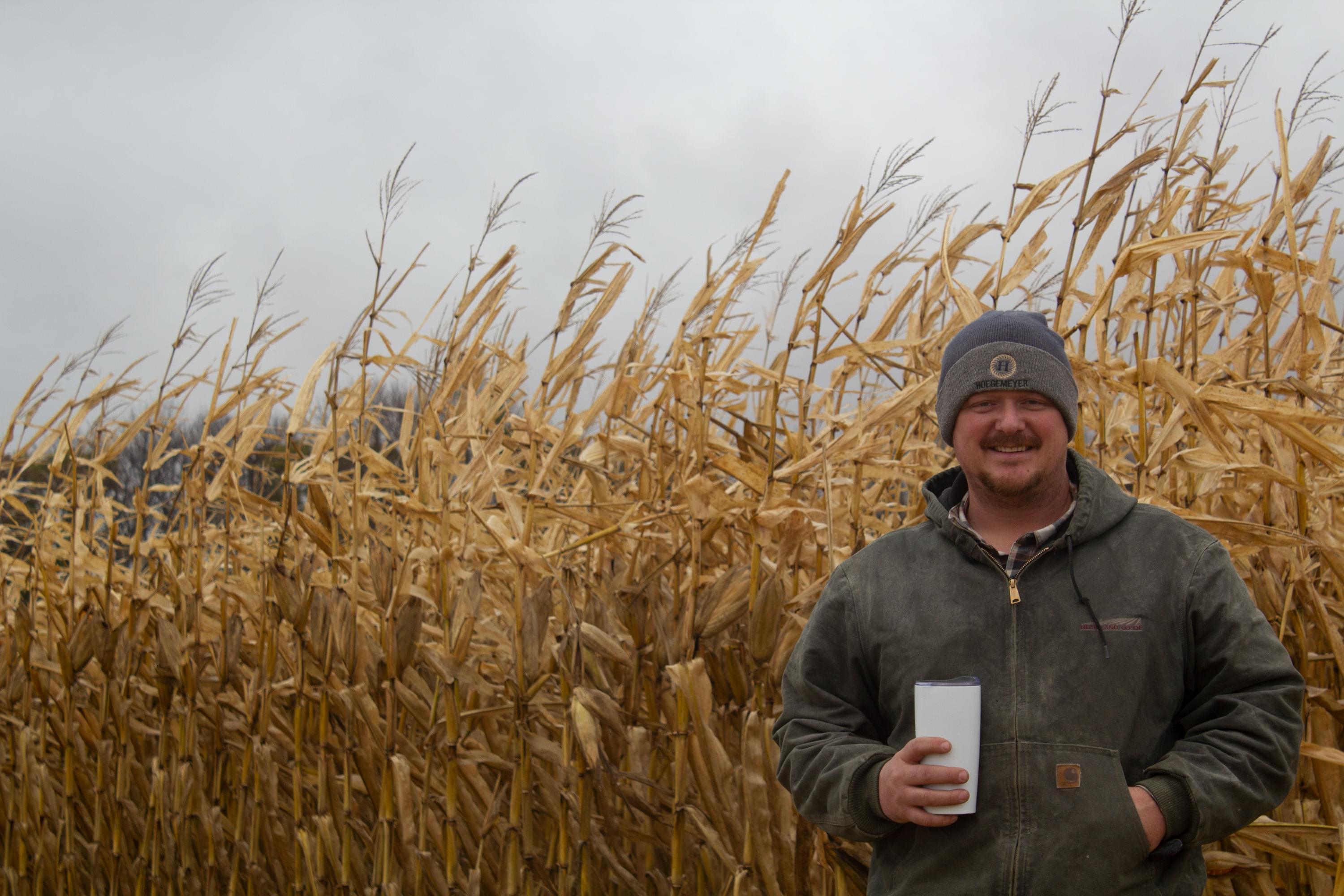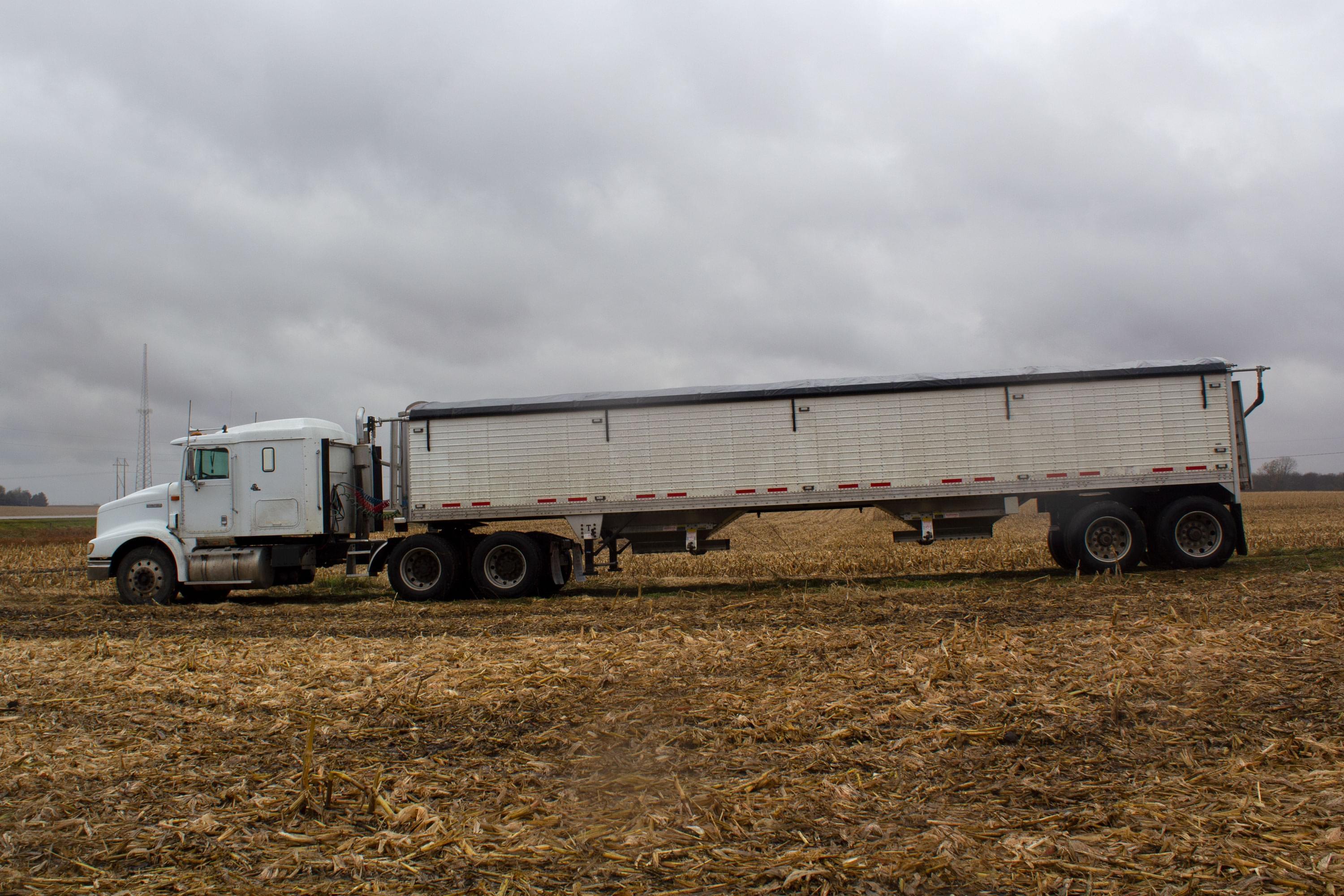2019’s Many Challenges Keep Farm Incomes Down, But Can’t Squelch Perennial Farmer Optimism

Central Iowa farmer Corey Hillebo climbs into the cab of his semi after picking up the receipt for corn he delivered to a grain elevator. Amy Mayer/Harvest Public Media
During 2019, the curveballs thrown at farmers began with the partial government shutdown in January, when some U.S. Department of Agriculture agencies were closed. Spring brought a storm system—called a bomb cyclone—that dumped rain on top of frozen fields unable to make use of it, kicking off weeks of flooding exacerbated by additional precipitation. Planting ran later than usual and some farmers never got a cash crop into certain saturated fields.
By high summer, parts of the Corn Belt experienced drought conditions and some farmers were still harvesting corn and soybeans after the first snow fell in autumn.
Through it all, farmers watched as the Trump administration continued its trade disputes with many partners. Negotiations did progress, but tariffs remain on soybeans, pork, beef, corn, wheat and other agricultural goods that U.S. farmers have grown accustomed to exporting.
All that did nothing to improve farm incomes, which have been falling since a peak in 2013. Over the past year, Chapter 12 bankruptcies, which apply to family farms, have inched up.
Still, when central Iowa farmer Corey Hillebo hauled a load of corn to the grain elevator in Elkhart on a rainy Friday, he remained upbeat.

Despite the many challenges he faced in 2019, Hillebo remains optimistic about the future of agriculture.
“I don’t think you can be a farmer without being somewhat of an optimist,” he said.
The corn he delivered didn’t fetch the best price because its moisture content was a bit high, but with his on-farm storage bins full he has plenty of quality grain to sell down the road.
Farmers know they’re at the mercy of freak storms and unpredictable weather. But Hillebo says some fixes to the trade situation would go a long way toward giving him hope for 2020.
“We gotta get the trade deal done,” he said, referring to an agreement with China and one with Canada and Mexico. “We’ve had some good news on that lately, but until something does happen I’m not going to expect anything.”
The United States and China have hinted at a “phase one” deal that could be signed soon, which might reduce some tariffs and increase some Chinese imports of U.S. agricultural goods. The United States-Mexico-Canada Agreement is sitting in the U.S. House. As recently as Tuesday, Sen. Chuck Grassley, R-Iowa, insisted it could pass the House and fly through the Senate before the end of the calendar year, though the number of days Congress is in session is dwindling and impeachment proceedings may eat up some more of those.
“Even if we were to sign a deal today, it would take several months for things to work themselves out,” said Chad Hart, an agricultural economist at Iowa State University. “And even then, you find that these trade battles have long residual effects. There's an echo that continues on because while it's easy to sort of put the tariffs on, for some reason it's incredibly hard to get them all taken off.”
Hart says the bottom line for many farmers in 2019 is that federal aid meant to offset losses from the trade war has been the difference between sinking and swimming. USDA plans another round of those payments before the end of the year.

Rain eventually ended the day's harvesting with less than half of the field complete.
“We're at break-even at best, at times. We've seen an erosion of the working capital on our farms,” Hart said, “so basically their cash reserves are dwindling each and every year as they basically just try to float by.”
The trade war certainly exacerbated the economic situation, but because farmers have been in a challenging environment for years, it’s hard to know just how much.
“The intuition, though, would suggest that an increase in tariffs would put downward pressure on exports, and I think that’s qualitatively true,” said Nate Kauffman, an economist with the Federal Reserve Bank of Kansas City. “I think that it’s just hard to get to a specific measure of exactly what the net affect has been.”
In fact, Kauffman says some of the weather events created small opportunities for farmers to gain a little money on sales of stored grain when prices briefly ticked up slightly. Blips like that helped prevent farm income numbers from falling as far as predicted.
“It doesn’t necessarily mean that that’s been a positive development, it’s just there’s been a little bit less pessimism than maybe what there was earlier in the year,” Kauffman said.
Kauffman says beef had been somewhat better off than other agriculture sectors for a while, but recently even that industry has grown volatile. A fire at a packing plant in Kansas worsened the situation.
“That disrupted almost 5 percent of the supply, and that's a huge number in a commodity market,” said southwest Iowa farmer Seth Watkins, who raises beef cattle.
He’s had a front-row seat for beef’s decline. His farm wasn’t deluged as thoroughly as those closer to the Missouri River, but he still dealt with flooding last spring and watched as demand abroad for U.S. beef, which had been building, slowed.

Seth Watkins, a farmer from southwest Iowa who raises beef cattle, spoke to sustainable agriculture students at Iowa State University on October 30, 2019.
“We'd just opened up China as a market, so beef has been very much impacted by the whole tariff issue,” he said.
Watkins remains hopeful. He knows a lot of farmers who’ve had a much rougher go of it. And yet, the almost unending onslaught of hurdles takes a toll.
“It's been a challenging year and I'm glad it's almost done.”
Follow Amy on Twitter: @AgAmyinAmes
Links
- By The Numbers: What The USDA’s Latest Census Tells Us About American Agriculture
- State Of Trump: NAFTA Talks Worry Agriculture Community
- U of I Researcher: Proposed Agriculture Budget Cuts Would Hurt Research On Climate and Crops
- Industry, Agriculture Leaders Support Lifting Trade Embargo With Cuba
